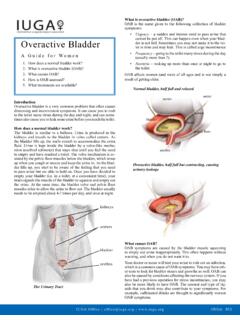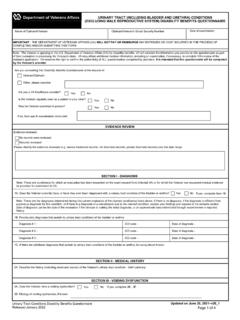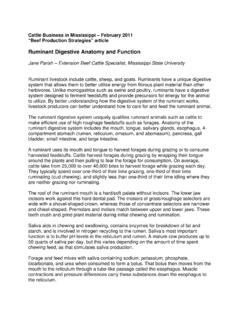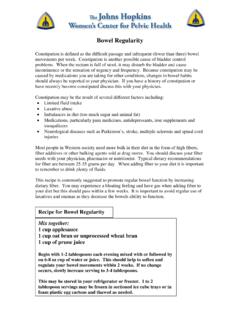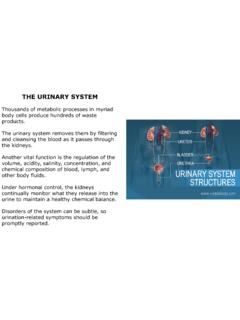Transcription of Reduced Bladder Emptying - Harrogate and District NHS ...
1 Patient and Carer Information Reduced Bladder Emptying The aim of this leaflet is to explain how your Bladder normally empties, what causes Reduced Bladder Emptying and what can be done to help. Reduced Bladder Emptying can occur gradually over a period of time or rapidly. It can also be a temporary or permanent problem depending on the cause. There are simple ways in which you can improve and aid Bladder Emptying . Also medical intervention is available which can help. How does the Bladder empty? The main function of the Bladder is to store urine and to assist in Emptying . The Bladder has to store enough urine to allow you to undertake daily activities and sleep at night. Maximum capacity of the Bladder is usually about 300-600ml. We usually empty when the Bladder is about two thirds full.
2 For the Bladder to empty fully you need: An intact nerve control system between your brain and the Bladder . This tells you when you need to pass urine and stores the urine until you are on the toilet. Once you are in a comfortable position and ready to empty your Bladder , the Bladder sphincter muscle and pelvic floor muscles relax. The Bladder simultaneously contracts and starts to empty itself of urine. This process allows the urine to flow and the Bladder to empty. It is not normal to strain to empty your Bladder . What can cause your Bladder to not empty properly? It may be due to one or a combination of the following reasons: Constipation a full bowel obstructs the passage of urine Enlarged prostate gland in men can obstruct normal flow Vaginal prolapse Nerve damage to the Bladder , spinal cord or brain accidental injury, multiple sclerosis, stroke, Parkinson's Disease, diabetes and dementia The Bladder muscle having been over-stretched previously ( after a period of short term or long term urinary retention).
3 After any surgery Certain medication. After childbirth After Botox injections for an overactive Bladder . Women, hovering' rather than sitting over the toilet Being in a rush and not allowing enough time to empty your Bladder . Reduced privacy public toilets or sitting on a commode behind curtains. Going too often and passing small amounts of urine, which reduces the Bladder muscle pressure and flow rate Why is it important to empty your Bladder ? Emptying your Bladder fully every 3-4 hours will reduce the likelihood of developing urinary tract infections, cystitis and protect your kidneys from damage. If your Bladder fails to empty and goes into retention, the Bladder muscle can become overstretched and can be damaged. An overstretched Bladder struggles to contract and empty the Bladder effectively.
4 Therapy Services PICG approval date: 16 August 2012 Page 1 of 2. Version FINAL. Patient and Carer Information Reduced Bladder Emptying How will you know you are not Emptying your Bladder ? The symptoms may include one or more of the following: Inability to pass urine. Increased frequency feeling that you want to go shortly after passing urine. Passing small amounts of urine. Urinary incontinence involuntary loss of urine. Poor urinary flow rate, hesitancy or straining to pass urine. When passing urine, the flow stops and starts (intermittency). Abdominal bloating or a feeling of incomplete Emptying Loin or abdominal pain What YOU can do to aid Bladder Emptying ? Bladder Emptying can be enhanced by the following: Avoid constipation. For women - sit properly on the toilet, with feet on the floor and leaning forward.
5 Men may also empty better when sat down. Give yourself time to empty your Bladder . If possible, use a quiet toilet where you can relax. Consider reducing the frequency to between every 2-4 hours When you think you have finished passing urine, sit for a few more seconds after the flow has completely stopped. Stand up and move a little; either lean forward and backward or walk on the spot. Sit down again and see if more urine is passed. Hand pressure over the Bladder just above the pubic bone while at the toilet. Drinking at least litres or 3 pints a day. Running the tap while sitting on the toilet. What can Health Professionals do to help you to empty your Bladder ? If your health professional suspects your Bladder is not Emptying a simple Bladder scan can be carried out to see how much urine is left in the Bladder .
6 If you are holding over 100mls on a regular basis and you are getting symptoms, such as frequent urinary tract infections, the following treatment options may be suggested. This will depend on the cause of your retention: A review of the medication you take. Medication or surgery to reduce the size of the prostate in men. Teaching the use of an intermittent self catheterisation 3-4 times a day. Temporary insertion of an indwelling catheter. For urinary retention in patients with Multiple Sclerosis the use of a Queens Square Bladder stimulator can help. If you have any questions speak to a Health Care Professional for individual advice 3If you require this information in an alternative language or format (such as Braille, audiotape or large print), please ask the staff who are looking after you.
7 Updated by the Specialist Continence Service January 2016. Therapy Services PICG approval date: 16 August 2012 Page 2 of 2. Version FINAL.






